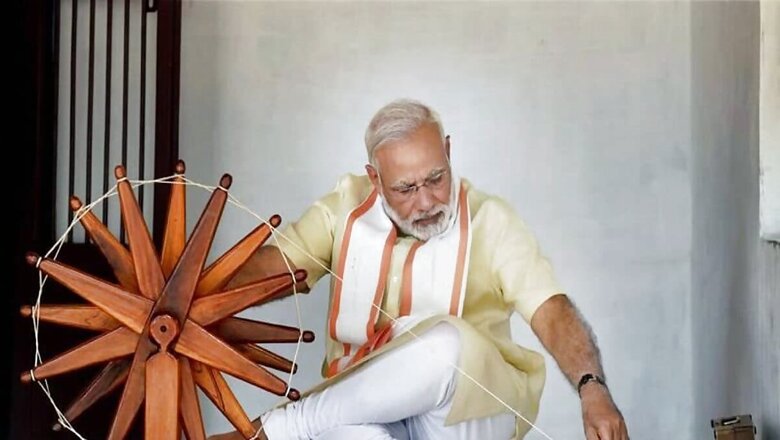
views
Khadi, the biggest of all Swadeshi icons, must get the boost it deserves. Very few Indians know Mahatma Gandhi’s beloved fabric is no longer a pushover and is now counted among the biggest-selling FMCG products in India. Indians need to be reminded that Khadi was seen as a symbol of India’s self-respect by Gandhi during the freedom movement.
It was in 1918 when Gandhi used Khadi as a key part of the Swadeshi movement to boycott the use of imported products and materials. He was confident this would help lift India out of poverty by creating industry and jobs locally, freeing India from its reliance on expensive fabric imported from Britain, even though the raw materials originated in India.
It was crucial for Indians to take back what was theirs, using their own produce and skills to create their own wealth. Khadi was at the heart of this strategy when Gandhi asked every man and woman to plant and harvest their own materials for the yarn needed to create Khadi fabric. He urged every Indian, rich or poor, to spend some time each day spinning Khadi. Entire villages adopted the movement, weaving their way to economic freedom through fashion.
The Khadi spinning wheel, known as the charkha, actually featured on India’s first flag before it was replaced with the Ashoka Chakra. The word ‘Khadi’ itself is derived from ‘khaddar’, a term for handspun fabric in India, Bangladesh and Pakistan. While Khadi is usually manufactured from cotton, contrary to popular belief, it is also made from silk and woollen yarn (called Khadi silk and Khadi wool respectively).
There are some very interesting, historical facts about Khadi. Hand-spinning and hand-weaving were known to Indians for thousands of years. Archaeological evidence, such as terracotta spindles (for spinning), bone tools (for weaving) and figurines wearing woven fabrics, indicate that the Indus Valley civilisation had a well-developed and flourishing tradition of textiles.
Prime Minister Narendra Modi is also pushing for the growth of this fabric and has explained recently how Khadi was ignored after independence and how the weavers suffered. But PM Modi also said that the push needs to happen from all quarters and how the thread of Khadi — inspiration for India’s freedom struggle — can become a source of inspiration for a developed nation and Atmanirbhar Bharat.
So let me toss some figures here.
The Khadi and Village Industries has clocked Rs 1.15 lakh crore turnover in FY22 as compared to Rs 95,741 crore in FY21 on the back of some solid support from the government. India is very hyped on Khadi, I am told. The Textiles Ministry has a database of 30 lakh artisans and if each artisan earns some Rs 1,000 per month, their lives can be transformed.
There are many advantages to producing and promoting khadi, a perfect example of eco-friendly and sustainable clothing which leaves the least carbon footprint. Gandhi was extremely conscious of sustainability and carbon footprints. He was a forward-thinking leader and he knew protecting the planet meant acting responsibly.
Khadi is a movement that continues to live on in Indian culture and will forever connect fashion with freedom in its truest form. The fabric is traditionally made from cotton and natural fibres like silk and wool are also used. The biggest advantage of Khadi is that irrespective of the fibre, no machines, factories or emissions are involved in the spinning and weaving stages. It is nothing but pure people-power and skill. And what one gets is a versatile fabric which is warm in winter and cool in summer.
Compared to the production of other fabrics, manufacturing Khadi is more sustainable. Producing one metre of Khadi requires just 3 litres of water, as opposed to 56 litres needed for the same length of mill fabric. This is a big one, considering India’s environmental concerns and water crisis in the hinterland.
Contemporary writer Peter Gonsalves has called Khadi a clothing for liberation that Gandhi used effectively to send a strong message to both Indians and the British. The writer said Khadi was used as a symbol of homogeneity, absence of status, simplicity and nakedness or uniform clothing. Given its uniqueness and high quality, the demand for Indian Khadi and Khadi-based products has been steadily increasing across global markets, including the US, UK, UAE and Germany.
In the last decade, there has been an increased emphasis on the concept of self-sustenance, Make in India and Atmanirbhar Bharat. Thousands of startups have emerged in Tier-II, Tier-III cities and the hinterland, India’s startup ecosystem has become the third largest in the world. What does this mean? It means India’s need to rely on foreign companies for products is dwindling. Given the steady upswing in demand for Khadi and India embarking on its Atmanirbhar Bharat journey, it’s likely to spur greater economic growth and development. This is a very good sign.
So what can happen if the production of Khadi is given a boost? The surge in the usage of Khadi can serve as a powerful tool for the emancipation of rural India. It needs to be remembered that India’s core ideas and principles are relevant and intertwined in almost every aspect of the nation’s society, and Khadi is its biggest testimony. Nearly seven decades after India gained independence, Khadi continues to inspire and amaze people around the globe.
Even with such a rich past, many Khadi loyalists argue that the true essence of the word has been lost over the years. They even argue that the label is being tossed around because of its new-found appeal in the fashion industry and also in Bollywood. But if there is an appeal for Khadi and it is spreading fast across the length and breadth of the country, I would call it a great sign.
So what should we do?
India should make Khadi more independent than before and create an independent ecosystem, which would include the original Gandhian purpose and principles of the cloth, and also trying to get it into the market. It will be the biggest gift to the father of the nation.
The author is Rajya Sabha MP, Chairman of the Parliamentary Standing Committee on Transport, Tourism & Culture. Views expressed are personal.
Read all the Latest Opinions here



















Comments
0 comment